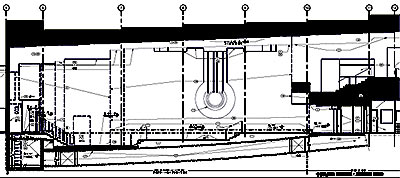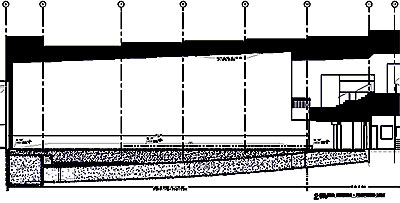
It looks like the former Alabama Theater — known since the early eighties as the Alabama Bookstop, and since last fall as that big vacant space for lease in Weingarten Realty’s Alabama Shepherd Shopping Center — is about to be gutted. A local construction company is currently taking bids from subcontractors for a rather complete interior demolition. The plans, prepared by Heights Venture Architects, show major alterations to the floor, walls, and ceilings.
The theater’s original sloped floor will be buried under a new concrete slab; wood floors inserted during the 1983 bookstore conversion will be removed. For now, the balcony will remain.
Here’s a little before and after to demonstrate:
***
A building section view, before the demo:

The demo view shows a new flat floor at stage level, and a stripped ceiling:

The bid documents refer to a Staples, and drawings for a prototype Staples store are included with the interior demolition plans.
Did Staples executives ask Weingarten to gut the theater before they’ll move in? Or is Weingarten just hoping that the office-supply retailer will become interested in the space once it’s rid of all those fussy Art Deco details and murals?


The bid documents don’t show any plans for the theater’s exterior.
Update: See Swamplot’s latest coverage of the Alabama Theater.
- Alabama Shepherd Shopping Center [Weingarten]
- Previously on Swamplot: Alabama Bookstop Theater: The Balcony Is Closed for This Performance, Alabama Bookstop Stop Date: September 15th, When Will the Alabama Bookstop Stop?, and How To Demolish Houston Landmarks
Images: Heights Venture Architects (exterior photo and drawings); Flickr users mlsnp (balcony view) and photine (stage [license])





So sad, but I’m afraid there’s nothing that can be done. Staples? Ughh.
Weingarten will likely keep the exterior the same as long as the commercial space is enough for a retailer to use. As for Staples, I guess all the deliveries will have to roll through the doors versus the usual loading dock?
No surprise here. Weingarten is run by complete idiots (if you own some of the most beloved buildings in the city but can’t figure out how to capitalize on their history and popularity for profit, and your only solution is always to gut or demolish them, you’re a loser) and Heights Venture, well, their “work” speaks for itself, and not well.
Such a shame one of the arts groups couldn’t find a way to turn this into an actual venue of some sort. But then they’re like the preservationists. Long on ideas. Short on action. Once the interior is gutted, who cares about the marquee? Might as well just remove it and put on a post like Weingarten did with the Village Theatre. And call it preservation.
Is there a need for that type store in the area?
Does anyone know if that art deco interior is original to the building? Might there be other artworks or details remaining from the original theatre that should be saved? Was it covered up behind the walls, or was that all demolished when Bookstop moved in? It really is a shame that neither Weingarten Realty nor Staples can see any value to keeping the structure and interior as-is. It seems that it would be more cost-efficient to occupy a well-kept space instead of paying for a total build-out, so none of this makes sense.
This is just … sad. I can still remember my first visit to this place (1986) when you could spend hours in Bookstop, have lunch at Buteras (now Zake sushi) and buy organic at Whole Foods (now PetsMart). I’m holding on to my memories, because Weingarten has taken away everything else.
Yay! Another big-box national retailer! Office Depot’s a few blocks away so we’ve got to have a Staples too! Like Walgreen’s and CVS! OK, enough exclamation points. I do think there gets to be point that its “theatre” identity gets compromised enough that it loses a lot of its historic value. To their credit, Bookstop made an effort to specifically avoid that.
Hopefully, they’ll let Historic Houston pull for salvage?
If this conversion allows this property to reach its’ most efficient use then so be it. However, I find it unlikely that a retailer such as Staples will occupy a property that so deviates from their traditional business model…stand-alone big boxes in suburban areas or adjacent to frontage roads.
Staples has actually changed there format to utilized smaller facilities. The Staples that opened at Taylor and I-10 is much smaller than the Staples of the past. The space in this center is adequate, but I would still have issues for inventory storage and for the loading dock they typically need.
In the end, Staples is likely part of a rumor. Regardless of the use of this space, Weingarten needs to adjust it to make it marketable.
This is a crying, goddamn shame.
I’m not positive but I think the is some kind of loading access, between the theatre and Petsmart on the backside.
Aside from that, Weingartens is run by a bunch of bozos and a Staples at this location is totally uneeded.
disgusting.
even if my life depends on a acquiring a stapler, i will not patronize this terrible addition to the neighborhood.
I think your right.
I used to live in the neighborhood and go to the PetSmart all the time (i rather my dog be mad at the groomer trimming his nails than me). I think it’s between the PetSmart and the theatre space.
Why do we continue to allow the “brains” at Weingartens ruin this special area of town. The inside of the theater is one of the most beautiful historic interiors remaining in Houston. Staples? Please – something that won’t ruin the theater. Weingartens charges $13,000/month rent – we know they aren’t broke – can’t they work with someone to keep this wonderful place intact? The Houston Cinema Arts held their Hermes opening there last year – it was wonderful.
kjb434, When you suggest that Wiengarten adjust the building to make it marketable, are you referring to adding a laoding dock as an example? Does a realty company really need to re-build to fit a marketing effort? Is it not feasible to market to the facility’s existing strengths as-is?
Brenda, find a business opportunity that can afford that rent and keep the space and your problem is solved.
Weingarten doesn’t want to spend money to clean out the space, but to make it marketable to someone who will actually pay, they have to gut it.
Just tear the theater down and put everyone who cares out of their misery. There’s nothing the city cares to do about it, no one seems to have a viable option that Weingarten is interested in, and cheap big boxes are where the general public prefers to shop. The fact that the building has architectural merit and the local demographics would support something unique or local are not the owner’s concern – their track record is well known.
Is good will no longer a strong marketing tool, distinguishing and separating one product, one store from its competitors?
Once again in this city, an irresponsible act without a hint of imagination or creativity, either on the part of the architects or Weingarten, a serial killer.
River Oaks Theater? Can you hear them coming?
Hopefully, they’ll let Historic Houston pull for salvage?
______________
Pull what? The walls and ceilings? Cut them out and haul them off and do what with them? Auction them off at some benefit so some chi-chi Weingarten investor can install them in their home as if they’ve saved a piece of a Picasso?
Jimmy,
That theater has been occupied as a non-theatre venue for years. I’m sure if tenant wanted it and paid more than Bookstop, Weingarten would have gladly leased it to them. For the months that Bookstop has vacated the space, no one jumped in and leased the space. It has been on commercial marketing sites and the locals have known about. It’s even been in the local news papers when Bookstop moved out.
Weingarten most likely got no bites. It’s cheaper for them gut the space so that a new leaser can quickly get set up.
Eife,
Good will? Pay the rent and I’m sure Weingarten would gladly let you keep it the way it is.
I find it funny how the same people that rail against strip centers want a piece of this one preserved so much. It is old strip center now better than a new one? In the end it is a strip center will art deco interiors and exteriors.
Houston strikes again. I’m ashamed and sickened by the city’s continued demolition of our history. Greed wins out again.
I’m leaving Houston to it’s strip centers and traffic. This is no longer home.
Jan Zollars
Good-bye! We won’t miss the complaints!
I have such fond memories of going there growing up with my late mother. I cried when they closed Bookstop but I atleast was able to take my children there to see the beautiful place full of books. I just can’t believe its gone nor that will be completely destroying that beautiful space.
BOOOOO!!!!!!! I will boycott anything that moves into that building if they screw with the inside.
I’m surprised the whole building hasn’t been bulldozed and turned into a McDonald’s or Burger King. That would about par for the course in Houston.
This city refuses to protect historical buildings and thus this is what we get. Sad but a consequence of our community’s refusal to set some minimum standards and land use controls.
Historic buildings need to represent a value. Just existing isn’t enough. What does it provide?
People that demonize Weingarten should be thanking them. They could have easily demolished the whole place and built a modern one set back on the property away from Shepherd. They have managed to maintain the existing character of the building. They have done more to preserve the historic character of the “building” than most.
Again, anything that you deem historic can be easily saved if you accept the value of the place. It’s actually being quite fair. A land use control (strict historic preservation) would be completely unfair and biased to one small group of people. Houston doesn’t gain from historic preservation like cities such as New Orleans does. New Orleans has too strictly protect their historic structure because of their value to the local economy. Houston never had architecture that if saved would benefit the community (other than just some warm squishy feelings).
I wish that they would put all of the stray cats in the area in the building before they level off the floor with concrete.
LOL! There are perfectly good restaurants nearby to serve the cats to its patrons.
I wish they’d put an Alamo Draft House in there but I don’t think it would fit enough screens. An inner-loop Alamo would do amazing, especially in the area.
“Houston never had architecture that if saved would benefit the community (other than just some warm squishy feelings).”
You’re kidding, right?
kjb434 writes:
“I find it funny how the same people that rail against strip centers want a piece of this one preserved so much. It is old strip center now better than a new one? In the end it is a strip center will (with?) art deco interiors and exteriors.”
—————————-
Yes. Like the River Oaks Shopping Center. And the Tower Theatre shopping center, though its historic elements were basically ruined by (surprise!) insensitive alteration to benefit big-box retailers. (Although I don’t remember any particular art deco details on the Alabama Center beyond those on the theatre.) I don’t see it as being such a difficult concept to say that _theatres_ have a certain cultural significance, that, say, warehouses might not. Additionally, it seems cut-and-dried to me that structures of a certain age with certain historic architectural details should be preserved. Without question, and regardless of whether the owner could make more money for the land by tearing down or massively altering the structure. Obviously the market is never going to dictate something like that or even make it possible for preservationists to afford to preserve much of anything. But it the pendulum of public policy always swings, and it sure seems like it’s gone about as far in the unrestricted development direction as it can. And, sorry, you can’t use the “urbanist” anti-strip center argument to argue against preservation of historically significant structures which happen to be part of strip centers, clever though it may seem.
“People who demonize Weingarten should be thanking them”.
WHY? You go thank a publicly-traded REIT.
I’m sure they’ll give a rat’s ass, kjb.
Your post #28 reeks of stupidity, IMHO.
I do believe they should just demo or gut the thing. My ties only go back to midnight movies in 1976 (about 35 years)
as well as several hundred book purchases.
I know others go back decades further.
You advocate an UGLY world, kjb.
Udunno,
Does or did Houston have something similar to the Strand in Galveston? The Vieux Carre or Uptown in New Orleans? Georgetown in D.C.? Art Deco in South Beach? The central area of Savannah?
At most, I see people going after single structures. Not whole districts. Outside of the Westmoreland and Audobon areas in the Montrose which is attempting to preserve the old homes, there really isn’t an area that hold architectural “VALUE” to the city. And in VALUE, I mean generates a benefit to the city in saving.
Marmer,
So this means the faux Tuscan homes and tack strip centers must be saved 70 years from now? The big box centers of today should not be torn down in the future if they happen to get to a certain age?
What is the metric that should be utilized here? At the core, most of the arguments rest on the idealistic concepts that “it’s the right thing to do” and “i loved that place so it can’t change”.
Why is it OK for someone have complete control over someone elses property with no benefit to the owner? Proper historic districts such as the Vieux Carre are done because they are economically beneficial to community. The community that saves it has an economic interest in the preservation. What’s the real benefit in forcing this old theatre to not change the way it looks?
I’m not saying I want this place to go are will do a dance of joy when it is gutted. I would just rather people make rational argument that has more depth than “memories”.
Actually kjb we did. Our Strand and Vieux Carre was Market Square, and lower Main Street, Uptown and central Savannah was River Oaks and Montrose – South Main Street before the 20’s. Art Deco district? try City Hall and the Gulf building. The elements within the districts used for comparisons grow fewer each day as they are demolished. We won’t have the chance to compare single elements if they keep disappearing, much less create a district like you reference in other cities.
Outside of Market Square and three residential areas, you haven’t mentioned much.
Market Square is safe. River Oaks has their own rules for homes which they relaxed because they had a problem of more abandon homes appearing with no one wanting repair or rebuild within the rules.
Individual buildings will survive is they prove their usefulness. City Hall is safe because is a staging area and represents the city. Several historic downtown buildings have been saved through economic interest. They have either been updated or re-purposed.
We don’t have and never had historic structures that could pull in visitors to or complement a visit to Houston.
Houston doesn’t have a storied history that ties it to grand historic events such as a war. Houston’s founding was a business venture that benefited from it’s nearest competitor being leveled in a Hurricane. Something history buffs could dive into and studied the various nuances of, but not something the city could sell for tourism. Where is or was our Alamo? We have a monument the represents a bigger historic event than the Alamo, but other than that the location was a swampy bank of Buffalo Bayou.
Kjb and his utility arguments reveal a basic truth about real estate. While many people care about architecture, history, and planning, a developer can make more money off of quick, cheap, and familiar. Figure out what the lowest common denominator is, make it more vanilla, and reproduce. Creativity, interest, passion, vision, legacy? Not if it costs a penny. Leave that crap to fools of the past like Jesse Jones, et al.
What Weingarten represents is the lowest common denominator of development. Serve plain vanilla to the masses without any sense of style or interest. Forget fins on a Cadillac, give them a mini-van. Simple, utilitarian, and boring.
Not everyone is Gerald Hines, developing with an eye toward a legacy, and hiring notable architects while making money. Most are like Weingarten, in it to turn a quick buck and nothing else. They’re not architects, they’re bankers.
I think it sucks that this theater is going to get gutted. It’s one of the last examples of a type of building that was central to the culture of its day. It was place where people could spend an afternoon in a place that was more luxurious than their home, and be exposed to the news of the day, movies, and socialize. Think of all the imaginations that were fired in that in that building.
And it will be replaced by a building central to the culture of its day, for better or worse. An uninspired place where you can accomplish your task cheaply, without thinking or chatting, and is austere enough to make you want to get home and consume your goods asap. And that’s all that Weingarten is interested in providing. A perfect match.
Kjb,
I think you miss the point about what makes a historic district valuable. It’s not that something has to be tied to a historic event, it’s about continuity. What the hell happened in the Gas Lamp in San Diego? A whole lot of nothing. But what it does have are blocks of uniterrupted old buildings where nothing happened. And lo and behold, it became a district whose property value skyrocketed due to continuity. Continuity that existed thanks to historical preservation and a touch of zoning.
Market Square is safe? Really? Because when I look out my window I see it’s bounded on two sides by surface lots that held old buildings until the eighties. It can’t be much of a neighborhood or district when its parts are so scattered.
The Vieux Carre started being preserved from development in earnest in the 1930s. The idea is that while a lot is worth more with a new structure, if the entire neighborhood is preserved, that lot will be worth just as much. It starts with preservation, it doesn’t end with it. That’s why the Quarter is still there.
“An uninspired place where you can accomplish your task cheaply, without thinking or chatting, and is austere enough to make you want to get home and consume your goods asap.”
And that is why Weingartens and their ilk had best make their megabucks quick because folk like me don’t bother with driving to someplace like Staples when it’s a mere mouse click away.
I hear a lot of negative comments on here about Houston’s history but no solutions and especially no long term solutions? History cannot be made, preserved and be economically viable in the short-term. All the major American historical cities and neighborhoods were not made in a day!
Also, I doubt Art foundations or non-profits can compete monetarily with Weingarten’s shareholders values.
kjb, you raise some good points in Post #36. I don’t claim to have all the answers about how to decide what is historically or culturally important enough to be worth saving. If it were to be my task to come up with some kind of metric, it would probably include age, historical context, “authenticity,” and scarcity. If there were 50 art-deco movie palaces in Houston, then one more or less wouldn’t matter that much to anyone. Now that there are only a couple, it seems appropriate to save them because they represent an art form and a kind of life that is also disappearing. And I don’t buy that preserving the theatre as a theatre is of no benefit to the owner. As others have stated, an Alamo Draft House or similar would make a lot more money for Weingarten than having it sit empty. I don’t think that saving the facade alone is nearly enough. Likewise, I wouldn’t be as concerned with saving something that was reproduction art-deco or reproduction Tuscan or reproduction Spanish Mediterranean from today as I would with something from the 30s and 40s. Of course I can’t speak for the future but that seems like a good starting point. The presence of architectural detail or significant craftsmanship also seems to be a likely factor for determining eligibility for preservation.
Finally, you seem to be implying that historic districts only make sense where significant tourism dollars are at stake. I can’t prove you are wrong though I think that’s overly simplistic. I am pretty sure, for example, that the Strand and Vieux Carre survived ONLY because depressed economic conditions in those areas slowed re-development enough for public awareness and opinion to evolve toward preservation.
Also, I doubt Art foundations or non-profits can compete monetarily with Weingarten’s shareholders values.
________________________
All Weingarten cares about is the rent. Not that much really given the ability to raise money in a town where the bigger the check you write the more often you appear in the society columns.
And of course then there’s the Cultural Arts Council which I think is called something else now. Probably as a diversionary tactic. How much didn’t they give away last year?
Cap’n McBarnacle said:
Kjb and his utility arguments reveal a basic truth about real estate. While many people care about architecture, history, and planning, a developer can make more money off of quick, cheap, and familiar. Figure out what the lowest common denominator is, make it more vanilla, and reproduce. Creativity, interest, passion, vision, legacy? Not if it costs a penny. Leave that crap to fools of the past like Jesse Jones, et al.
————————–
Yeah, that pretty much sums it up. Back when I worked real estate, being a visionary was something of a liability. I’ve been laughed at in my face before by coworkers because I pitched an idea that was outside of the box.
.
I made a couple of investments that were, as you describe, driven by creativity, interest, passion, vision, legacy, AND also by ego. And on paper, they also made sense financially, but they turned out to be money pits. I really believed in them at the time and made an honest-to-goodness effort. But now I’m broke (and feel broken), am doing temp work for the Census, have no other prospects, and am looking at military options. The only redeeming quality about these investments is that they’d be so difficult to sell at this point that the bank doesn’t seem to want them back.
.
If I invest again in real estate, it will be a much more boring endeavor, a commoditized investment following a traditional set of strategies. I’d want for a contractor to be able to show up at the job site, glance at the plans, and know EXACTLY what to do because they’ve done it a hundred times before.
.
“Build me a rectangular prism.”
Thank GOD we’re getting a Staples! I mean, what would I have done if I had to go to Kirby and Richmond to Office Max or West Gray and Dunleavy to Office Depot???
It’s like why I was glad they put in that Barnes and Noble in place of the West Gray shopping center. Borders and Bookstop were like BLOCKS away! Plus, bonus Starbucks! Who DOESN’T want three Starbucks within 50 yards of each other???
/sarcasm
Staples @ Alabama theater will be an mega backdrop for a new series of Gonzo vids. Can recruit the hotties @ pappas across street, feed em some cocktails, and then showtime! quit the grinnin and drop than linen, ya dirty lil hooker.
The “property rights uber alles” types like KJB always rail about how unfair it is to tell a property owner what he can/cannot do with his property when we are discussing saving Houston’s historic buildings, but never seem to have a problem with telling hundreds of people/businesses what to do with their property (move out and sell it to TxDot) when it comes to expanding freeways and toll roads.
*
Thank goodness cities like NY, SFO, Chicago, Paris, London, Rome, and the like know better. They did not allow the destruction of Radio City Music Hall, Coit Tower, the Burnham Building, the Eiffel Tower, Harrod’s, the Colusseum. All of these were scheduled for demolition at some point by developers and naysayers. More than 15 million people a year don’t go to Paris to see the newest Staples. Some cities owe their greatest industry, tourism, to the built environment – primarily great buildings.
*
If some had their way, at some point all of these buildings would have been demolished to make way for the next great thing or Barnes & Noble. If every place followed the example so often promoted by some; that only temporary and immediate profit matter, then most of the civilized world would be nothing but strip centers and big box stores today; after all they are cheap and provide a quick return to shareholders. Does anything else matter?
*
The irony is that so many of those saved buildings continue to be, well, commercially profitable despite the protestations to the contrary. It is amazing how resourceful we are at making money, no matter what the conditions. Historic, landmarked commercial buildings all over the country continue to provide profits to their owners who simply had the skills to adjust. It’s not that hard, except for Weingarten, in Houston where they don’t have to. Yet.
*
Thankfully, most places have local and regional governments that are not as clueless as those of Houston and Texas; so that 50 years from now when Houston has been completely covered in concrete and 50 lane toll roads, our grand kids will still have grand places to visit – out of town.
John,
I like how pin TxDOT for kicking people out of the property but haven’t mentioned METRO? Biased? Both have the ability for purposes relating to eminent domain in the Constitution. There’s a clear distinction you are completely failing to grasp.
Eminent domain power has been abused recently under the Kelo decision, but many states have enacted laws to circumvent the misguided Supreme Court ruling.
kjb434, Yes I’m completely biased and unlike some, freely admit it. I believe TxDot is managed by morons who haven’t had an original idea about how to improve the transportation infrastructure in 50 years. If it doesn’t involve bull-dozing neighborhoods, homes, and businesses to lay ever wider swaths of concrete – they can’t imagine it. Metro’s impact on the COH has been negligible compared to the wholesale destruction of private property by TxDot. I-10 has been widened 3X in my lifetime alone. What will they do 10 yrs from now, add 30 more lanes? I believe that TxDot has become nothing more than the welfare teet for the highway construction industry. And please layoff reciting policy to me. All policy including the Constitution is open to interpretation and all policy can be changed.
^^^^^^^^
Statements like that reveal your lack of knowledge in the topic of TxDOT.
TxDOT is given it’s mission by the state legislature. TxDOT CANNOT IN ANYWAY EVER EVER DO RAIL UNTIL THE STATE LEGISLATURE CHANGES THEIR MISSION AND PURPOSE. The same used to be true for toll roads until recently which is why groups such at HCTRA exist.
What TxDOT and what METRO does is one in the same regarding eminent domain.
Back to the topic at hand, eminent domain for the used of saving historic structures would be a complete abuse of the original intent.
kjb434
Have I offended you? Do you work for TxDot? Trust me, it’s not personal.
*
You wrote, “Statements like that reveal your lack of knowledge in the topic of TxDOT.”
*
Statements like that reveal your arrogance and poor manners. You have no idea what my knowledge is, though on this board you do seem to believe that you possess knowledge greater than all others.
*
And there you go reciting policy again. Every organization has a mission, it’s the execution that counts. Whoever said that TxDot should build rail?
*
BTW, I don’t equate strict regulations to protect important buildings to eminent domain. No one is suggesting the seizure of private property. The use of “policy” to restrict the destruction of some property, even private property, is not exactly a new idea and has been held up to be constitutional. No need to reinvent this wheel.
Kjb, what’s the point of living in an urban area if you can’t preserve any of what made it special? Your utilitarian outlook seems better suites for the suburbs.
You know, I consider myself a libertarian-conservative, but I haven’t spouted your ideological drivel since college. Then I grew up.
Could The Niche contact me? I have some money burning a whole in my cash account… probably not enough so don’t get TOO excited…
Whats next…the Astrodome? ha ha ha
Saaaaad. VERY saaaaad. I miss the bookstop terribly, and the spectacular interior which will now be concreted over and sterile. I don’t like it…and thankfully I won’t have to shop there either!
“I believe TxDot is managed by morons who haven’t had an original idea about how to improve the transportation infrastructure in 50 years.”
“Every organization has a mission, it’s the execution that counts. Whoever said that TxDot should build rail?”
—————————
Then what exactly ARE you suggesting that they should do?
As usual, KJB shows just how big a douchenozzle he truely is.
Yes, calling me names and insulting me is the first line of someone without the knowledge to debate and issue.
Real mature.
What’s the viability of turning it back into a theater? A local theater was demolished for a Wendy’s fast food store which went out of business last year. People are now saying they wished they had a theater in the area to draw customers to the downtown area!
What is wrong with you people in Houston–why do you keep letting this shit happen to your city under the funny banner of ‘progress’?
What is wrong with you people in Houston–why do you keep letting this shit happen to your city under the funny banner of ‘progress’?
____________________
Did you know we had our own witch at one time? We did. Sybil Leek. Who moved here from Florida. And on her way back to Florida, she commented that Houston reminded her of a karmic cesspool. If nothing else, she was very observant.
very sad to see this happening. I worked there through out the 90’s and I really miss that building. too bad Half Price couldn’t move in!
too bad Half Price couldn’t move in!
_____________________
They possibly could but then they probably would have to change the name to Three-Quarters Price Books.
Thanks to John and Cap’n Barnacle for utterly destroying any credibility kjb brought to this discussion.
Not that it was difficult.
And, of course, not that he would agree.
What a lonely, bitter fellow (IMO).
I like how I’m being attacked as someone against historic preservation.
If only you guys knew the truth.
Well, then spill the truth! That’s the beauty of this forum – no one but Gus can find us!
And just an aside – maybe I just never looked on the right days, but I don’t recall ever seeing this property listed on the Properties for Sale section of their website. Not certain how anyone outside the immediate scope of local fat-chewing is supposed to even know it’s available. Some out-of town investors do prefer to conduct their own searches in lieu of hiring an agent.
As kjb434 said elsewhere in this comment thread, “Houston never had architecture that if saved would benefit the community.” So his line of argument here is totally reasonable: He is a fan of historic preservation, but not in Houston, because nothing here has ever been worth preserving.
Not to say that I agree with him, mind you: I think dismissing any city’s architectural heritage out of hand is incredibly ignorant. But the guy is consistent.
Ok, if you are asking me to toot my own horn regarding historic preservation, here goes:
Worked with local residents of my hometown (Thibodaux, LA) to restore 10 home from the early 1840s when the town was founded.
Assisted in preservation efforts for Laurel Valley Plantation grounds to preserve the existing slave home and aspects to the old sugar mill.
Assisted in restoration effort of a late 1800s bayou side warehouse in Thibodaux which is now in use as a part of the Jean Lafitte National Park which houses a Cajun history museum.
Worked in an effort to preserve the Laurel Grove Plantation. Plantation was in deep disrepair and in the end no investor could be found to transform the place. It has been dismembered for the wood and antique finishes that could be saved. The site is located at the corner of LA State Highway 308 and 304 along Bayou Lafourche.
Assisted in fund raising efforts to repair Laura Plantation which was damaged in a horrible electrical fire in 2004. The restorers completed the work 2006. Hurricane Katrina was a little interruption to the efforts, but since major electrical repair was part of the restoration effort, the lack electricity after the storm wasn’t much of a problem. Laura Plantation is located on the west bank of the Mississippi River in St. James Parish near the community of Vacherie.
Some other work as part of community efforts was in restoring old graves in St. Joseph cemetery in Thibodaux. Several grave date back to the Civil War and have soldiers buried within them. Think of the cemeteries in New Orleans and you can get a picture of what this one looks like.
The important point in the restoration efforts is that the groups that lobbied for restoration worked with the landowners (some who didn’t care of the state of the property like in the Laural Valley slave homes). Laurel Grove was a disappointment, but a long shot to begin with.
I’m not again historic preservation, but I find is silly and immature for people to attack Weingarten. If anybody could approach them with an idea or a plan to keep the theatre and turn it into a money making investment for any kind of use, I’m sure they’ll listen.
If Weingarten could get a tenant without any changes to the space, wouldn’t you think they’ll go for that. They save a lot of money in that situation. They most likely looked into the gutting of the place since there isn’t much option for them.
Saving a place purely on moral grounds that it is the right thing to do isn’t enough. It’s a place to start, but it’s a lot more that has to happen after that. In the end, a philanthropist or investor or a group of a combination of the two is needed. This group can either buy it out or develop a plan that Weingarten could get their rent and the place be saved.
When I mentioned places like the Vieux Carre in New Orleans, I was trying to get to the point that restoration there never happens for restoration sake without an investor involved except for buildings that were utilized for public purposes (such as The Cabildo and The Presbytere which flank St. Louis Cathedral (Basilica)). If no one is there to make use of the old buildings, they’ll fall into disrepair.
Excellent! Not only the work, but it does lend some clarification to what you personally consider worthy of historic preservation efforts. Nothing wrong with that – I would fight for a Craftsman sooner than a Mid-Century Modern – that’s just me.
But back to the latter part of my post – does anyone recall seeing the Alabama property listed as available on the website? Just curious.
“If Weingarten could get a tenant without any changes to the space, wouldn’t you think they’ll go for that.”
No…they won’t. They don’t care about Houston or it’s history. They only care about money. They are no different than out of state apartment owners who never even come here or take care of their slums…it’s only about the bottom line.
Towards the couple of comments here and on the other threads taking it out on Barnes and Noble —
Borders most likely won’t be around much longer, and when Borders was built it killed the Ale House and was intended to kill Bookstop. Hate away at the big chains, but one isn’t better than the other when it comes to this story.
From JKPolk:
“Towards the couple of comments here and on the other threads taking it out on Barnes and Noble …”
*
JK, I think you miss the point. It isn’t about taking it out on Barnes and Noble, it’s about making a statement that Weingarten will appreciate.
*
We all agree, at least most of us, that Weingarten doesn’t give a damn about these issues; they only care about the bottom line. Their leadership can’t comprehend that being viewed as a positive instead of a negative by the communities where they do business could actually be good for business.
*
So, if all that matters is money; you have to get their attention by taking action that may be viewed as detrimental to their bottom line. If, for instance, the Houstonians that care had the nerve to boycott the River Oaks Barnes & Noble for say 30 days. Boycott, picket, and make lots of noise in the media getting the message across that even longer, louder boycotts will be organized against any retailer that agrees to occupy a “gutted” Alabama Theatre – maybe Barnes & Noble will be angry enough, prospective tenants will be wary enough, and Weingarten will be startled enough, that they may begin to rethink the way they manage these types of properties. Maybe not, but it’s worth a shot.
*
New Yorkers would do it. People in Boston, SFO, and Chicago would do it. As a life-long Houstonian, I’d be shocked that it could happen here. Houstonians don’t generally march, boycott, or get really angry about much. We are a complacent bunch. It’s sad.
*
Most property owners who own these types of buildings don’t save them because they want to; they do it because local laws force them to. Without those types of regulations in Houston, we have to use other methods, perhaps.
The story tugs at the artist in me. However, the accountant in me understands that talk is cheap, and money talks, BS or complaining walks. If I were a rich man, I’d purchase and save it. If I were a manager I’d get some people together, pool our resources and save it. If I were an executive, I’d hire lawyers, bankers, realtors, and my golf buddies to get together to save it. But to spend time here to whine and complain accomplishes exactly what happened with the Health Care Bill. Someone needs to DO something. I’d like to be that someone. But I am not.
Maybe you are?
It’s a shame some weren’t mindful of the fact that someday Wallis Annenberg would control the Annenberg Foundation. She of course could buy the whole center.
And have some fun with it too. She could name it for her sons. Charles Annenberg WEINGARTEN and Gregory Annenberg WEINGARTEN.
Maybe I’ll pass it on. You never know…
Matt Mystery. What a treasure she would be creating, and what a wonderful legacy. This could compete with and overshadow the Menil complex. Oh, yes I did say that. I’m bored: Off with their heads. LOL.
She could even open a restaurant to pull in some extra cash to support it all and honor the other “claim to fame” of La Grange besides The Chicken Ranch and name the restaurant for her daughter. Lauren Bon’s Ton.
Staples response:
Dear Andrea,
While there has been speculation about Staples in connection with the historic Alabama Theater, we do not have a lease agreement at this location. Staples will continue to be a good neighbor that supports the communities where its customers and associates live and work as the company continues expanding in the Houston region. The rumors, however, have sparked a larger debate about the location. Therefore, we recommend that concerned citizens direct their letters and suggestions to Weingarten Realty as we are not involved in this development.
Many thanks,
Amy Shanler
PR Director
Staples, Inc.